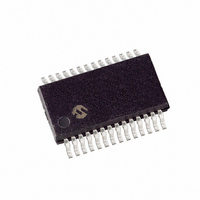PIC16F870T-I/SS Microchip Technology, PIC16F870T-I/SS Datasheet - Page 76

PIC16F870T-I/SS
Manufacturer Part Number
PIC16F870T-I/SS
Description
IC MCU FLASH 2KX14 EE 28SSOP
Manufacturer
Microchip Technology
Series
PIC® 16Fr
Datasheets
1.PIC16F616T-ISL.pdf
(8 pages)
2.PIC16F688T-ISL.pdf
(688 pages)
3.PIC16F870-ISO.pdf
(172 pages)
4.PIC16F870-ISO.pdf
(6 pages)
Specifications of PIC16F870T-I/SS
Core Processor
PIC
Core Size
8-Bit
Speed
20MHz
Connectivity
UART/USART
Peripherals
Brown-out Detect/Reset, POR, PWM, WDT
Number Of I /o
22
Program Memory Size
3.5KB (2K x 14)
Program Memory Type
FLASH
Eeprom Size
64 x 8
Ram Size
128 x 8
Voltage - Supply (vcc/vdd)
4 V ~ 5.5 V
Data Converters
A/D 5x10b
Oscillator Type
External
Operating Temperature
-40°C ~ 85°C
Package / Case
28-SSOP
For Use With
I3-DB16F871 - BOARD DAUGHTER ICEPIC3
Lead Free Status / RoHS Status
Lead free / RoHS Compliant
- PIC16F616T-ISL PDF datasheet
- PIC16F688T-ISL PDF datasheet #2
- PIC16F870-ISO PDF datasheet #3
- PIC16F870-ISO PDF datasheet #4
- Current page: 76 of 172
- Download datasheet (4Mb)
PIC16F870/871
9.3.2
Once Synchronous mode is selected, reception is
enabled
(RCSTA<5>), or enable bit CREN (RCSTA<4>). Data is
sampled on the RC7/RX/DT pin on the falling edge of
the clock. If enable bit SREN is set, then only a single
word is received. If enable bit CREN is set, the recep-
tion is continuous until CREN is cleared. If both bits are
set, CREN takes precedence. After clocking the last bit,
the received data in the Receive Shift register (RSR) is
transferred to the RCREG register (if it is empty). When
the transfer is complete, interrupt flag bit RCIF
(PIR1<5>) is set. The actual interrupt can be enabled/
disabled
(PIE1<5>). Flag bit RCIF is a read only bit, which is
reset by the hardware. In this case, it is reset when the
RCREG register has been read and is empty. The
RCREG is a double-buffered register (i.e., it is a two-
deep FIFO). It is possible for two bytes of data to be
received and transferred to the RCREG FIFO and a
third byte to begin shifting into the RSR register. On the
clocking of the last bit of the third byte, if the RCREG
register is still full, then overrun error bit OERR
(RCSTA<1>) is set. The word in the RSR will be lost.
The RCREG register can be read twice to retrieve the
two bytes in the FIFO. Bit OERR has to be cleared in
software (by clearing bit CREN). If bit OERR is set,
transfers from the RSR to the RCREG are inhibited, so
it is essential to clear bit OERR if it is set. The ninth
receive bit is buffered the same way as the receive
data. Reading the RCREG register will load bit RX9D
with a new value, therefore, it is essential for the user
to read the RCSTA register before reading RCREG, in
order not to lose the old RX9D information.
DS30569B-page 74
by
by
USART SYNCHRONOUS MASTER
RECEPTION
setting
setting/clearing
either
enable
enable
bit
bit
SREN
RCIE
When setting up a Synchronous Master Reception:
1.
2.
3.
4.
5.
6.
7.
8.
9.
10. If any error occurred, clear the error by clearing
11. If using interrupts, ensure that GIE and PEIE
Initialize the SPBRG register for the appropriate
baud rate (Section 9.1).
Enable the synchronous master serial port by
setting bits SYNC, SPEN and CSRC.
Ensure bits CREN and SREN are clear.
If interrupts are desired, then set enable bit
RCIE.
If 9-bit reception is desired, then set bit RX9.
If a single reception is required, set bit SREN.
For continuous reception, set bit CREN.
Interrupt flag bit RCIF will be set when reception
is complete and an interrupt will be generated if
enable bit RCIE was set.
Read the RCSTA register to get the ninth bit (if
enabled) and determine if any error occurred
during reception.
Read the 8-bit received data by reading the
RCREG register.
bit CREN.
(bits 7 and 6) of the INTCON register are set.
2003 Microchip Technology Inc.
Related parts for PIC16F870T-I/SS
Image
Part Number
Description
Manufacturer
Datasheet
Request
R

Part Number:
Description:
IC MCU FLASH 2KX14 EE 28SOIC
Manufacturer:
Microchip Technology
Datasheet:

Part Number:
Description:
IC MCU FLASH 2KX14 EE 28DIP
Manufacturer:
Microchip Technology
Datasheet:

Part Number:
Description:
IC MCU FLASH 2KX14 EE 28SSOP
Manufacturer:
Microchip Technology
Datasheet:

Part Number:
Description:
IC MCU CMOS 20MHZ 2K FLASH 28DIP
Manufacturer:
Microchip Technology
Datasheet:

Part Number:
Description:
IC MCU CMOS 20MHZ 2K FLSH 28SSOP
Manufacturer:
Microchip Technology
Datasheet:

Part Number:
Description:
28 PIN, 3.5KB ENH FLASH, 128 RAM, 22 I/O,
Manufacturer:
Microchip Technology
Datasheet:

Part Number:
Description:
IC MCU FLASH 4KX14 EEPROM 18DIP
Manufacturer:
Microchip Technology
Datasheet:

Part Number:
Description:
IC MCU FLASH 4KX14 EEPROM 18SOIC
Manufacturer:
Microchip Technology
Datasheet:

Part Number:
Description:
IC MCU FLASH 4KX14 EEPROM 20SSOP
Manufacturer:
Microchip Technology
Datasheet:

Part Number:
Description:
IC MCU FLASH 4KX14 EEPROM 28QFN
Manufacturer:
Microchip Technology
Datasheet:

Part Number:
Description:
IC MCU FLASH 4KX14 EEPROM 18SOIC
Manufacturer:
Microchip Technology
Datasheet:

Part Number:
Description:
IC MCU FLASH 4KX14 EEPROM 20SSOP
Manufacturer:
Microchip Technology
Datasheet:

Part Number:
Description:
IC MCU FLASH 4KX14 EEPROM 28QFN
Manufacturer:
Microchip Technology
Datasheet:

Part Number:
Description:
IC,MICROCONTROLLER,8-BIT,PIC CPU,CMOS,DIP,18PIN,PLASTIC
Manufacturer:
Microchip Technology
Datasheet:

Part Number:
Description:
IC, 8BIT MCU, PIC16F, 32MHZ, SOIC-18
Manufacturer:
Microchip Technology
Datasheet:










